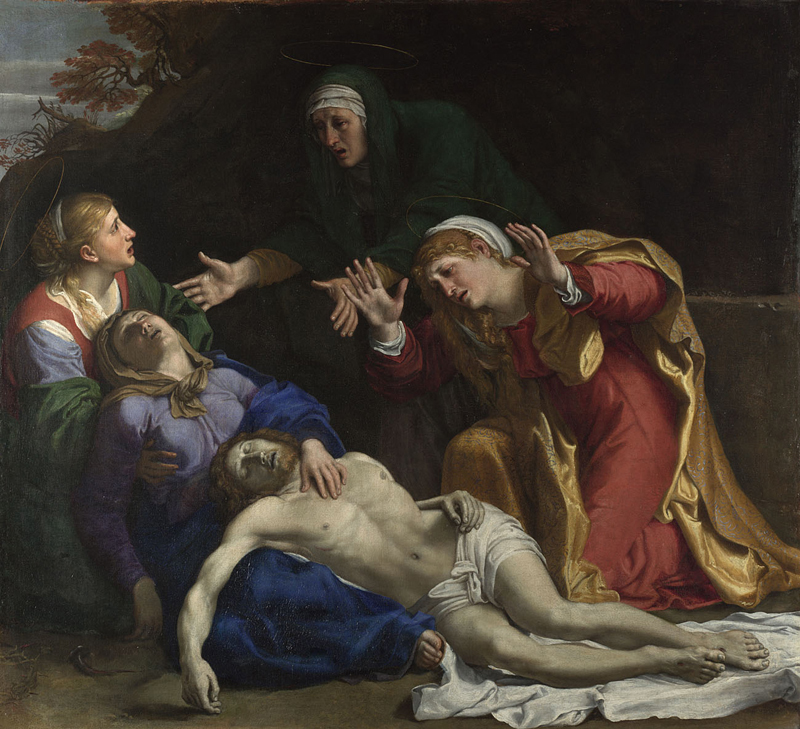High Prices: The Carracci Brand

Annibale Carracci, The Dead Christ Mourned, about 1604, oil on canvas, National Gallery, London
In 1798 Annibale Carracci’s Pietà in the Orléans Collection was the most expensive painting in London, and probably the entire world. Crowds of spectators congregated around it at the great Manchester Art Treasures exhibition of 1857, creating “a furore” as “the most popular object of attraction in the Galleries.” Few critics failed to mention its high price. A critical about-face quickly followed as the classical style, of which the Carracci were paragons, was judged decadent, and—a subject of intense debate in those years—academic. Carracci prices dropped precipitously for a century. It would probably surprise people today that Carracci’s Pietà was once so wildly expensive as to call to mind a contemporary spectacle of high price, the Leonardo Salvator Mundi.
High prices were a signal attribute of the Bolognese Carracci family of painters during the period of their activity, circa 1580–1619, and long after. High prices provide a point of departure for my exploration of the Carracci through the lens of the art market, cast as a case study, but with the belief that it will also serve to illuminate the art-historical moment more broadly. Beginning by pulling at the thread of conspicuously high prices, I propose that the Carracci deliberately conceptualized their identity as something akin to a name brand that persisted for centuries, that became ever more capacious and successful, and that could operate on terms quite independent of the properties of actual works. While branding for marketing purposes (as opposed to marking ownership) is an anachronistic term, it helps to tease out different aspects of the Carracci’s own practices. For example, the Carracci institutionalized their identity in the family’s academy, promulgating their reform of painting and inculcating their values into a new generation of artists. Frequented by the local nobility, the academy even served to “market” the Carracci to potential patrons. In collaborative commissions, Lodovico, Agostino, and Annibale Carracci sublimated their individual manners to a collective style in their campaign to establish and disseminate the Carracci name. I would argue that the family developed their name like a brand, insisting that their painting was “by the Carracci, we did it together.”
Carracci prices are entangled with honor, ambivalence about money, ambition, desire for immortality, social and professional status, economic survival, competition, skill, friendship, and family tensions. Prices are eventually correlated with “taste” and the concept of brand is useful in reevaluating this problematic variable. Branding has been of interest for contemporary art, but not for premodern periods, and I have benefited from studies on branding in other fields. Fortunately, art history, art market studies, and cultural economics offer a recent bonanza of relevant publications, but scholarship on the Italian market still lags behind that of Northern Europe. Lacking the North’s overt structures, business organization, and visibility, the stubbornly regional Italian market has almost to be inferred, transaction by transaction, and it raises questions about what has been considered normative about the art market more broadly.
The published primary documentation reveals that the Bolognese were almost exclusively interested in Bolognese art, and the correspondence of agents tells a story of aggressive collectors from elsewhere hunting for increasingly scarce works by the Carracci and their former pupils, like Guido Reni: by far the highest price for any painting in Bologna in 1676 was for Annibale’s Resurrection. By 1700 a confluence of collecting and dispersal coinciding with the rise of the grand tour resulted in a demand that could not be met. With original paintings almost unobtainable, drawings, copies, or even school pieces sold for high prices.
Cultural economics offers new perspectives on factors affecting price, financial value, innovation, and hedonic pricing. Especially useful in evaluating a correlation between the nebulous category of taste with price is the work of Kathryn Graddy, who analyzed Roger de Piles’s Balance (1708), a table that rates artists according to their excellence in categories like composition, drawing, and color. Graddy correlates de Piles’s ratings to demand and price over time and presents the “superstar model,” in which top-rated artists grow ever more valuable; the Carracci score very high, just below Raphael and Rubens. The Carracci formed part of the canon, discussed by most important art critics over three centuries. A link to their critical fortune is crucial to price. I am now embarking on an analysis of prices using the sales, inventories, and dealer stock books databases of the Getty Research Institute Provenance Index. What did the (brand) name Carracci mean, encompass, and evoke, especially in the criticism and in the salesroom, and how does this discourse correlate with price?
San Diego, CA
Edmond J. Safra Visiting Professor, spring 2023
Gail Feigenbaum will return to San Diego. She will finish editing a book about the transatlantic art market from 1880 to 1930 and continue research for an article about the historical art market for the Carracci.


